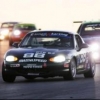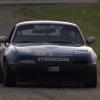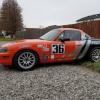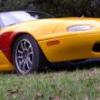Obviously I am against trail braking in most instances. The majority of my time is spent looking at cars from various points on the track. When I see a mid pack guy, with brake lights on after turn in, I reccomend that he stop it. When he does, he almost always goes significantly faster. You can do physics and math and traction circles. I measure with a stop watch. Faster lap times wins in my book.
Set up guide; Always remember what I mentioned earlier, you are looking for balance. Using the front setup from shop A with the rear setup from shop B will not usually be fast. Set up is a reciepe, you can not use part of grammas brownies, with some ingrediants from Aunt Jemima and a few more from Betty Crocker. You will usually end up with a brown pile of... Also, every oven is a little different, so always go by what your oven wants.
First the car must be mechanically sound, no bad bushings, wheel bearings etc.
Second you must be accurate
Third you must be repeatable.
What Adavanced does:
Front camber +/- 3.5 neg
Front Caster even side to side, about 25% above minimum for the car. Varies by year of subframe
Front toe, out 1/16" out per wheel as measured with 24" toe plates. Measureing with a string box off the wheel lip will give different readings.
Rear camber equal to front
Rear toe IN 1/32 per wheel with toe plates.
within 10 pounds of 50/50 crossweight, I learned with pounds not %
level at pinch welds
front bar soft for 1.6 cars
rear bar middle middle
33-36 pounds tire pressure hot depending upon driver feel
My primary adjustment is to the rear bar and rear ride height/rake at the track. Once the rear bar is set to driver preference, it usually stays put. Then I just do tire pressure and rear ride height for rake. Many drivers prefer the low hot pressures, but find the car too squishy on cold tires, so they compromise with the higher pressure for stability at the start.
Remember you can adjust one side of the rear bar at a time. Middle soft is a common setting.
Front toe: This is overly simplified. It does not take into account weight transfer, ackerman, caster curves. But it is easy to understand. Grab 2 pens and create your front tires.
Set you pens for zero toe. Now turn them 1/2" to the right. They both are the same angle into the corner. But the inside wheel should be turned more than the outside due to the radius of the turn being longer for the outside wheel.
Now put 1/2" toe into the pens. Again turn them 1/2" to the right. You have the inside pen at straight ahead and the outside at a drastic angle into the corner. This will create the opposite scenario of what you want. The outside wheel is pointed in when compared to the inside.
Now go 1/2" out on each pen. Turn them right 1/2" You now have the preferred angles. Outside will be straight ahead, while the inside will be turned in. The outside tire is turning at a larger radius than the inside tire. Just what we want.
This description is way overly exaggerated. But you can see the effect of front toe, on turn in. I personally like a hard turn in, so I go a little higher than normal. But that is MY preference. And I really don't care how fast I go. I race for fun only.
Rear toe needs to be slightly toed in for braking stability. The rear wheels will slightly toe out under braking, toe out in the rear is unstable. All you need is a little toe in to offset the toe out tendency. That slight rear toe in, will also help mid corner/on power stability. Especially the middle of a sweeper.
Figure out YOUR recipe, using your oven(tools) and always do it the same way.
Hope this helps
Dave
Dave Wheeler
Advanced Autosports, the nations most complete Spec Miata shop
Author, Spec Miata Constructors Guide, version 1 and 2.0
Building Championship winning cars since 1995
4 time Central Division Spec Miata Champion car builder 2012-2013-2014-2017
Back to Back June Sprints Spec Miata 1-2 finishes 2016 and 2017
5 time June Sprints winner in Mazda's
6 Time Northern Conference Champion Car Builder
2014 SCCA Majors National point Champion car builder
2014 SCCA Runoffs winner, T4 (Bender)
2014 Central Division Champion, ITS (Wheeler)
2013 Thunderhill 25 hour winning crew chief
2007 June Sprints winner, (GT1, Mohrhauser)
Over 200 race wins and counting.
www.advanced-autosports.com
dave@advanced-autosports.com
608-313-1230




 Sign In
Sign In Create Account
Create Account





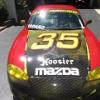





 Back to top
Back to top Report
Report

